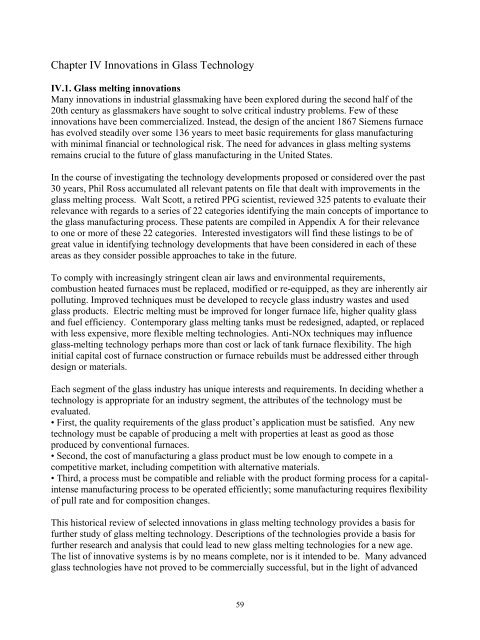Glass Melting Technology: A Technical and Economic ... - OSTI
Glass Melting Technology: A Technical and Economic ... - OSTI
Glass Melting Technology: A Technical and Economic ... - OSTI
Create successful ePaper yourself
Turn your PDF publications into a flip-book with our unique Google optimized e-Paper software.
Chapter IV Innovations in <strong>Glass</strong> <strong>Technology</strong><br />
IV.1. <strong>Glass</strong> melting innovations<br />
Many innovations in industrial glassmaking have been explored during the second half of the<br />
20th century as glassmakers have sought to solve critical industry problems. Few of these<br />
innovations have been commercialized. Instead, the design of the ancient 1867 Siemens furnace<br />
has evolved steadily over some 136 years to meet basic requirements for glass manufacturing<br />
with minimal financial or technological risk. The need for advances in glass melting systems<br />
remains crucial to the future of glass manufacturing in the United States.<br />
In the course of investigating the technology developments proposed or considered over the past<br />
30 years, Phil Ross accumulated all relevant patents on file that dealt with improvements in the<br />
glass melting process. Walt Scott, a retired PPG scientist, reviewed 325 patents to evaluate their<br />
relevance with regards to a series of 22 categories identifying the main concepts of importance to<br />
the glass manufacturing process. These patents are compiled in Appendix A for their relevance<br />
to one or more of these 22 categories. Interested investigators will find these listings to be of<br />
great value in identifying technology developments that have been considered in each of these<br />
areas as they consider possible approaches to take in the future.<br />
To comply with increasingly stringent clean air laws <strong>and</strong> environmental requirements,<br />
combustion heated furnaces must be replaced, modified or re-equipped, as they are inherently air<br />
polluting. Improved techniques must be developed to recycle glass industry wastes <strong>and</strong> used<br />
glass products. Electric melting must be improved for longer furnace life, higher quality glass<br />
<strong>and</strong> fuel efficiency. Contemporary glass melting tanks must be redesigned, adapted, or replaced<br />
with less expensive, more flexible melting technologies. Anti-NOx techniques may influence<br />
glass-melting technology perhaps more than cost or lack of tank furnace flexibility. The high<br />
initial capital cost of furnace construction or furnace rebuilds must be addressed either through<br />
design or materials.<br />
Each segment of the glass industry has unique interests <strong>and</strong> requirements. In deciding whether a<br />
technology is appropriate for an industry segment, the attributes of the technology must be<br />
evaluated.<br />
• First, the quality requirements of the glass product’s application must be satisfied. Any new<br />
technology must be capable of producing a melt with properties at least as good as those<br />
produced by conventional furnaces.<br />
• Second, the cost of manufacturing a glass product must be low enough to compete in a<br />
competitive market, including competition with alternative materials.<br />
• Third, a process must be compatible <strong>and</strong> reliable with the product forming process for a capitalintense<br />
manufacturing process to be operated efficiently; some manufacturing requires flexibility<br />
of pull rate <strong>and</strong> for composition changes.<br />
This historical review of selected innovations in glass melting technology provides a basis for<br />
further study of glass melting technology. Descriptions of the technologies provide a basis for<br />
further research <strong>and</strong> analysis that could lead to new glass melting technologies for a new age.<br />
The list of innovative systems is by no means complete, nor is it intended to be. Many advanced<br />
glass technologies have not proved to be commercially successful, but in the light of advanced<br />
59

















